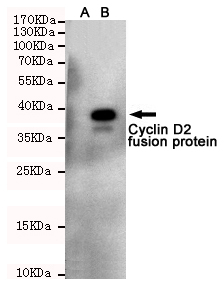-
Product Name
Anti-Cyclin D2 (6E11) Mouse antibody
- Documents
-
Description
Cyclin D2 (6E11) Mouse monoclonal antibody
-
Tested applications
WB
-
Species reactivity
Human
-
Alternative names
CCND 2;CCND2;CCND2_HUMAN;CyclinD2;G1/S specific cyclin D2;G1/S-specific cyclin-D2; KIAK0002;MGC102758. antibody
-
Isotype
Mouse IgG2b
-
Preparation
Antigen: Purified recombinant human Cyclin D2 protein fragments expressed in E.coli.
-
Clonality
Monoclonal
-
Formulation
Purified mouse monoclonal in PBS(pH 7.4) containing with 0.02% sodium azide and 50% glycerol.
-
Storage instructions
Store at 4°C short term. Store at -20°C long term. Avoid freeze / thaw cycle.
-
Applications
WB: 1/1000
-
Validations

Western blot detection of Cyclin D2 in CHO-K1 cell lysateuff08Auff09and CHO-K1 transfected by Cyclin D2-fragment EGFP fusion proteinuff08Buff09cell lysate using Cyclin D2 mouse mAb (1:1000 diluted).Predicted band size:38KDa.Observed band size:38KDa.
-
Background
Swiss-Prot Acc.P30279.The protein encoded by this gene belongs to the highly conserved cyclin family, whose members are characterized by a dramatic periodicity in protein abundance through the cell cycle. Cyclins function as regulators of CDK kinases. Different cyclins exhibit distinct expression and degradation patterns which contribute to the temporal coordination of each mitotic event. This cyclin forms a complex with CDK4 or CDK6 and functions as a regulatory subunit of the complex, whose activity is required for cell cycle G1/S transition. This protein has been shown to interact with and be involved in the phosphorylation of tumor suppressor protein Rb. Knockout studies of the homologous gene in mouse suggest the essential roles of this gene in ovarian granulosa and germ cell proliferation. High level expression of this gene was observed in ovarian and testicular tumors. Mutations in this gene are associated with megalencephaly-polymicrogyria-polydactyly-hydrocephalus syndrome 3 (MPPH3).
Related Products / Services
Please note: All products are "FOR RESEARCH USE ONLY AND ARE NOT INTENDED FOR DIAGNOSTIC OR THERAPEUTIC USE"
